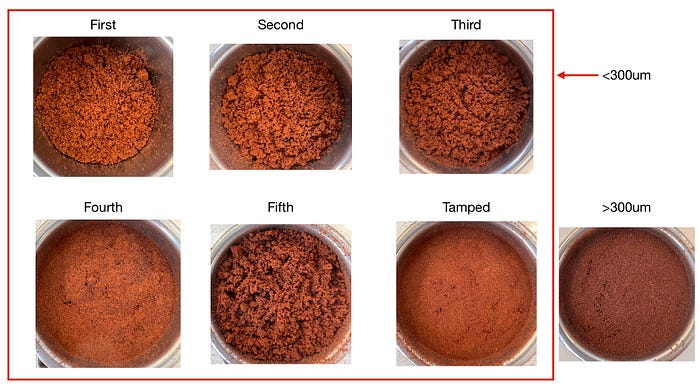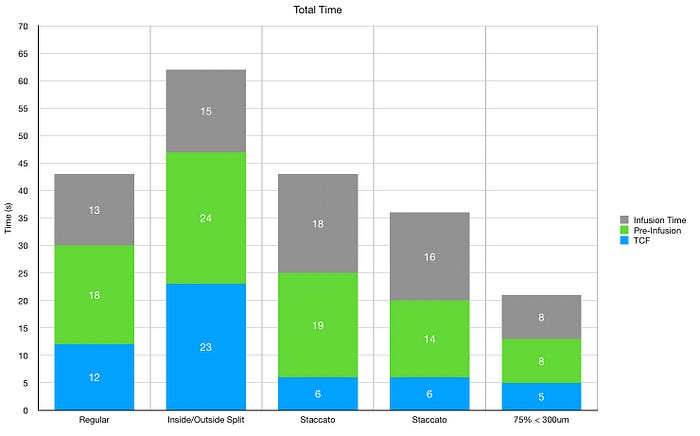Coffee Data Science
Regrinding Coffee 5 Times for Espresso
Espresso from Another Micron
Double grinding coffee became an interesting discussion a few years ago. However, the discussion hasn’t moved forward on why this is interesting. I looked at double grinding, and I found the more interesting part was separating the inside fines from the rest of the coffee.
This got me thinking about grinding and sifting a few times. If I sift out everything below 300um each time, would the particles mostly be the same particle size after a few rounds. So on a whim, I ground and sifted 5 times.

I used a Niche grinder, and I started at setting 30. Then I sifted using the Fellow Shimmy which sifts out particles less than 300um. I decreased the grind setting by 10, and I repeated the process.

It was time consuming, but the shot was pretty amazing. I was very much surprised because I had assumed it would channel and cause issues.

My main regret in this investigation was not recording particle distributions.
Equipment/Technique
Espresso Machine: Decent Espresso Machine
Coffee Grinder: Niche Zero and Fellow Ode with SPP Burrs
Coffee: Home Roasted Coffee, medium (First Crack + 1 Minute)
Shot Preparation: Staccato in spirit
Pre-infusion: Long, ~25 seconds
Infusion: Pressure Pulsing
Filter Basket: 20g VST
Other Equipment: Atago TDS Meter, Acaia Pyxis Scale
Metrics of Performance
I use two metrics for evaluating the differences between techniques: Final Score and Coffee Extraction.
Final score is the average of a scorecard of 7 metrics (Sharp, Rich, Syrup, Sweet, Sour, Bitter, and Aftertaste). These scores were subjective, of course, but they were calibrated to my tastes and helped me improve my shots. There is some variation in the scores. My aim was to be consistent for each metric, but some times the granularity was difficult.
Total Dissolved Solids (TDS) is measured using a refractometer, and this number combined with the output weight of the shot and the input weight of the coffee is used to determine the percentage of coffee extracted into the cup, called Extraction Yield (EY).
Performance
To look at performance, I compared it to a few other shots of the same roast. I had a regular shot (staccato tamped), an inside grounds and outside split, and two staccato shots. The experimental shot in this case is called 75% < 300um because 75% of the coffee grounds are less than 300um.


This experimental shot outperformed all the other shots, and it ran far faster.

This experimental shot was much more labor intensive, but I think it gives a good lesson in grinding. One could make a grinding with a sifter and feed because to regrind only coarser particles or maybe the key is using a roller grinder instead.
If you like, follow me on Twitter, YouTube, and Instagram where I post videos of espresso shots on different machines and espresso related stuff. You can also find me on LinkedIn. You can also follow me on Medium and Subscribe.










